|
|
|
|
| ISSUE 62 | SEPTEMBER 2025 |
| |
 |
| |
|
|
| |
|
By now, classrooms are buzzing, and everyone is officially back in school. We hope your year is off to a smooth and successful start.
In this issue, we’re focusing on classroom management. You’ll find practical ways to make your Daily Routines manageable and meaningful, along with tips for establishing strong systems—from organizing reading groups to fostering student independence during small-group instruction. We’re also sharing easy-to-implement ideas for independent stations that will save time during weekly planning.
Don’t miss this month’s freebie—available for both the © 2017 and © 2026 editions of Superkids!
Here’s to a super start to fall!
|
| |
 |
| |
|
|
| |
|
Daily Routines, or the Daily Warm-Up if you are using the © 2026 edition of the program, are an essential part of every Superkids lesson. Managing them efficiently—especially with a large class—can feel overwhelming. Fortunately, there are strategies that can make this important time a breeze.
⏰ First, remember that Daily Routines/Daily Warm-Up should only take 10–15 minutes. Many teachers unintentionally extend this portion of the lesson, which can make it hard to fit in the rest of the daily instructional steps. A simple solution? Set a timer at the start of the routine. When the timer goes off, continue on with Word Work. This helps build consistency and keeps your lesson on track.
✏️ Another challenge teachers have shared is finding time to informally assess and document student progress during this time. Superkids coaches recommend dividing your class into four or five sections. Then, focus your observations on one section of students per day. Over the course of the week, you’ll gather helpful information on every child—without the pressure of tracking the entire class at once.
📋 To keep things organized, create a designated clipboard or folder just for recording observations during the routines. This weekly data catcher gives you a quick, at-a-glance overview that can guide your planning for small-group instruction and skill differentiation.
💻 Want to save even more time? Use the interactive Daily Routines available on MyZBPortal.com. Many teachers using the © 2017 edition of the program take advantage of these and the Daily Routine video lessons. Projecting one step of the routine, such as dictation and spelling, allows you to move around the room to support students and take informal notes. It’s a great way to maximize instructional time while keeping an eye on student progress.
With just a few simple adjustments, you can streamline your Daily Routines or Daily Warm-Up, collect valuable data, and make every minute count.
|
| |
 |
| |
|
|
| |
|
In Superkids, all students read on-grade-level texts—an exciting challenge that calls for intentional planning. To ensure every child can access and engage with the text, you’ll want to group students thoughtfully based on their reading needs.
One of the most effective ways to do this is by creating small, flexible groups. When children with similar reading abilities are grouped together, you can tailor your instruction to meet the unique needs of each group. Small-group time then becomes an opportunity to reinforce skills, provide targeted support, and stretch students’ learning in ways that whole-group instruction may not allow.
Most Superkids teachers find success by organizing their class into three reading groups:
- Group 1 includes students who often need support while reading and benefit from regular, focused skill reinforcement.
- Group 2 consists of students who may need help occasionally but can read much of the grade-level text independently. These students still benefit from additional practice with certain skills.
- Group 3 includes students who require minimal assistance, can read Superkids texts on their own, and are ready for enrichment activities that challenge and extend their learning.
To place students into groups, start with formal assessment data from the program. But don't stop there—informal assessments as students work through the lessons can offer valuable insights as well. Most importantly, keep in mind that these groups should remain fluid. As students grow, so should their placement.
|
| |
 |
| |
|
|
| |
|
Successful independent work time requires deliberate instruction, consistent routines, and plenty of practice. Building students’ capacity to work independently may take time at the start of the school year, but the investment will pay off in productive small-group time later.
At the beginning of the year, it’s helpful to practice the independent work portion of the day without simultaneously pulling small groups. This gives you the flexibility to focus on establishing and reinforcing expectations, modeling procedures, introducing activity directions, and providing immediate feedback. After each practice session, gather students for a quick debrief. Use this time to reflect on what went well and set goals for improvement.
When students are ready, begin transitioning to small-group instruction. Start by keeping group instruction short so you can remain available to assist students working independently. Over time, gradually lengthen group sessions until they reach the ideal duration of approximately twenty minutes each.
With clear routines, thoughtful modeling, and consistent practice, you create an independent work time that runs smoothly giving you the space to provide focused, small-group instruction.
|
| |
 |
| |
|
|
| |
|
Anchor stations are a smart, time-saving solution for your classroom. These are independent or cooperative centers with consistent tasks that remain largely the same throughout the school year. Instead of creating brand-new activities each week and reteaching directions, you’ll simply make small adjustments to existing activities that align with your students’ growing reading skills.
Introduce stations gradually using the gradual release model: I Do, We Do, You Do. Begin by modeling one center activity for the whole group. Then, allow students to complete the activity with your guidance and support. After sufficient guided practice, students should be ready to try the task independently. Once they have a clear understanding of how to complete the first station successfully, introduce new stations one at a time using the same gradual release approach.
As students move through the Superkids program, you will increase the complexity of their tasks and introduce new materials that align with the phonemes and skills they’ve learned—all while keeping the station structure consistent and familiar. Below are a few examples of anchor stations we have spotted in Superkids classrooms, along with ideas for how to update them to reflect your core instruction.
|
| |
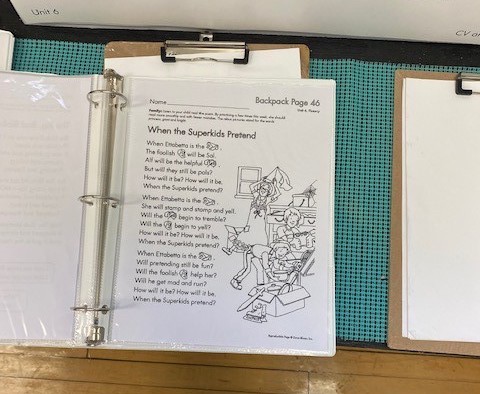 |
|
Fluency Binders
Superkids teacher Christa Kelly created six binders for a reading practice station where students build fluency by reading passages with a partner.
To keep the station current, simply add the latest fluency passage to each binder as it’s introduced during instruction. This ensures students are always practicing with text that aligns with their current skill level.
|
| |
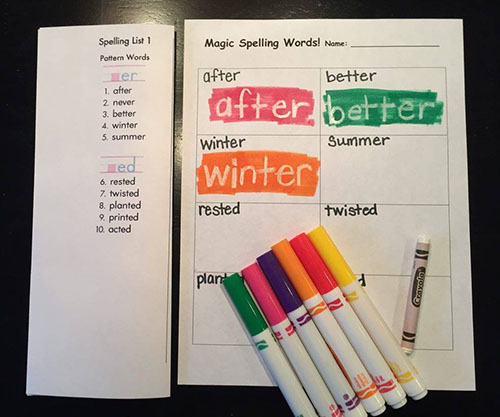 |
|
Spelling Station
To provide additional practice with spelling words or Memory Words, include station materials to complete activities like rainbow spelling, spelling stairs, or magic spelling (write words in white crayon and color over words with water-based marker).
To keep the station current, replace the word list to match the current unit.
|
| |
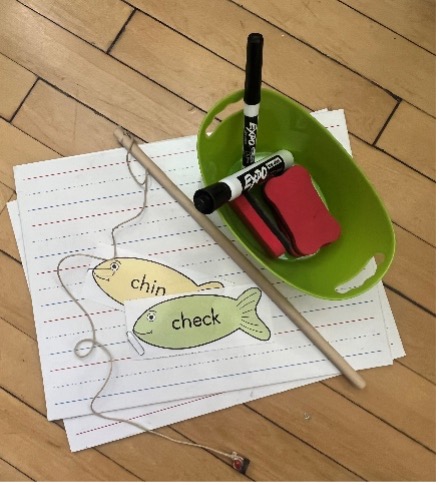 |
|
Something’s Fishy
At this station, students fish for Memory Words or decodable words printed on fishing game cards. Students catch a fish and write the word on a white board or piece of paper. When all the fish have been caught, students read the words to their group members and then release the fish back into the pond.
To keep the station current, replace fish cards with updated decodable words that include newly introduced phonemes or new Memory Words.
|
| |
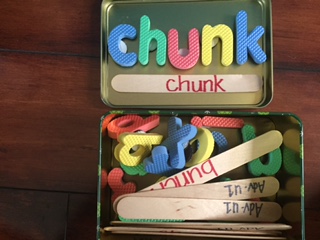 |
|
Word Building
This first-grade teacher uses cute word-building boxes as an anchor station all year. Students who need more support use a word stick to recreate a word and read the word to a partner. Students who need less support build the words that a partner reads aloud.
To keep the station current, change the word sticks to include words with new phonemes as they are taught.
|
| |
|
| |
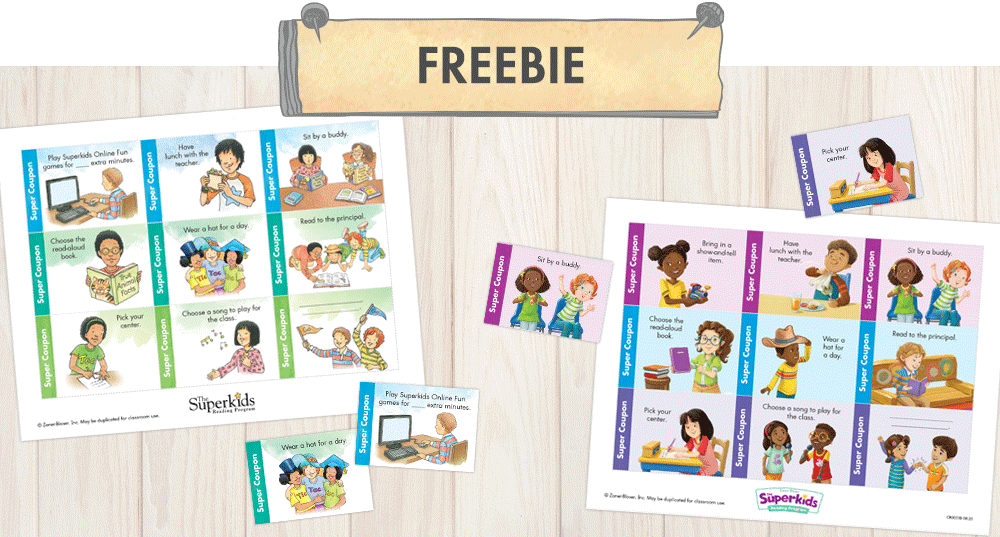 |
| |
|
|
| |
|
As you take intentional steps toward a super school year, don’t forget to stock up on Superkids Super Coupons—a fun and meaningful way to celebrate student success. This printable set includes eight reward coupons, featuring a variety of positive incentives students will love—plus a create-your-own option for personalized rewards.
NEW for the © 2026 edition of Superkids! We’ve added a fresh set of coupons featuring the characters from the new edition.
Download, print, and celebrate the little and big wins all year long!
|
| |
|
|
| |
|
|
|
 |
|
|
|
|